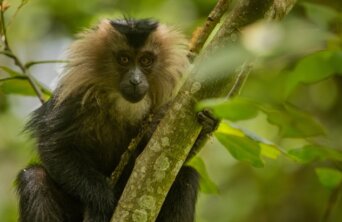- About
- Topics
- Story
- In-Depth
- Picks
- Opinion
- News
- Donate
- Signup for our newsletterOur Editors' Best Picks.Send
Read, Debate: Engage.
| topic: | Conservation |
|---|---|
| located: | India |
| editor: | Bindu Gopal Rao |
A rare sighting in India’s Western Ghats, the lion-tailed macaque (LTM) is a primate with a distinctive mane of hair around its head. It gets its name from its thin tail with a black tuft like a lion’s. Known to be forest dwellers, they are endemic to South India’s Western Ghats, and about 2,500 to 3,000 remain in the wild. They can be found in parts of Karnataka, Kerala, and Tamil Nadu in India.
The population of these primates is declining due to habitat loss from deforestation for timber and agriculture. Other factors endangering the lion-tailed macaque include illegal hunting, roadkill, and electrocution, all of which call for urgent remedial measures.
The State Government has established the Someshwara Wildlife Sanctuary, an unprotected reserve forest, to conserve the wildlife in Karnataka’s southern region, where many of these macaques reside. The International Union of Conservation Network (IUCN) has also listed the species as endangered, an essential step for their conservation.
LTMs contribute to a healthy ecosystem via seed dispersion. As they feed on fruits, they keep the seeds in their cheek pouches and drop them in different places as they move around, ensuring a good spread of native trees. Rapid urbanisation has caused a change in the primates’ behavioural patterns, another matter of concern.
A school of thought also advocates breeding in captivity, which is yet to be implemented. The species must have large tracts of continual rainforests for their survival. NGOs like the Nature Conservation Foundation have built rope bridges in some parts of the forests in Tamil Nadu, connecting canopies of rainforests that have been razed for roads.
While measures like these make some difference, the need of the hour is a concerted effort towards conservation, a need for joint participation from the state governments, municipalities, local forest departments, private landowners, and residents. People must also be educated to refrain from feeding primates and disposing of waste properly. Community-based efforts focus on conservation by gathering information on LTMs’ population status and challenges.
Image by Uday Kiran.

